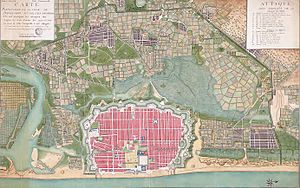Siege of Pondicherry (1778)
| Siege of Pondicherry | |||||||
|---|---|---|---|---|---|---|---|
| Part of the American Revolutionary War | |||||||
 French map depicting the siege, c. 1778 |
|||||||
|
|||||||
| Belligerents | |||||||
|
|
|
||||||
| Commanders and leaders | |||||||
|
Hector Munro Edward Vernon |
Guillaume de Bellecombe (POW) François-Jean-Baptiste l'Ollivier de Tronjoli |
||||||
| Strength | |||||||
| 1,500 British regulars 9,000 or more sepoys |
700 French regulars 400–600 sepoys |
||||||
| Casualties and losses | |||||||
| 77 British army killed 11 British navy killed 155 sepoys killed 193 British army wounded 53 British navy wounded 684 sepoys wounded |
92 French killed 52 sepoys killed 191 French wounded 94 sepoys wounded |
||||||
The Siege of Pondicherry was the first military action on the Indian subcontinent following the declaration of war between Great Britain and France in the American Revolutionary War. A British force besieged the French-controlled port of Puducherry in August 1778, which capitulated after ten weeks of siege.
Following the American victory at Saratoga in October 1777, France decided to enter the American War of Independence as an ally to the United States. Word first reached the French Indian colony of Pondicherry in July 1778 that France and Britain had recalled their ambassadors, a sign that war was imminent. The British colonies had already received orders to seize the French possessions in India and begun military preparations.
Pondicherry was the capital of French India and the largest of France's possessions on the subcontinent. The British would capture all of the other possessions without resistance in 1778; only Pondicherry was actively defended. The French governor, General Guillaume de Bellecombe, had at his disposal about 700 French troops and 400 sepoys (local Indian troops), and a city whose fortifications were in some disrepair. Pondicherry, as was the case with a number of other European colonial outposts in India, changed hands due to military action several times in the colonial period. Attempts to significantly improve its defences after the last round of battles in the Seven Years' War were frustrated by political infighting in the French colonial administration. In 1778 the outer works of the city were largely incomplete, with significant elements unfinished and parts of the city exposed to direct attack.
Bellecombe immediately set about improving the defences, working as quickly as possible in anticipation of British movements. Key gates were blocked, and gun batteries were constructed along the shore, and anything that might give cover to the British on their advance on the defences was removed or destroyed. Bellecombe also received additional troops before the British arrived. The garrison from Karikal (which the British occupied on 10 August) add about 100 sepoys to the defence, and some of Pondicherry's inhabitants also took up arms.
...
Wikipedia
